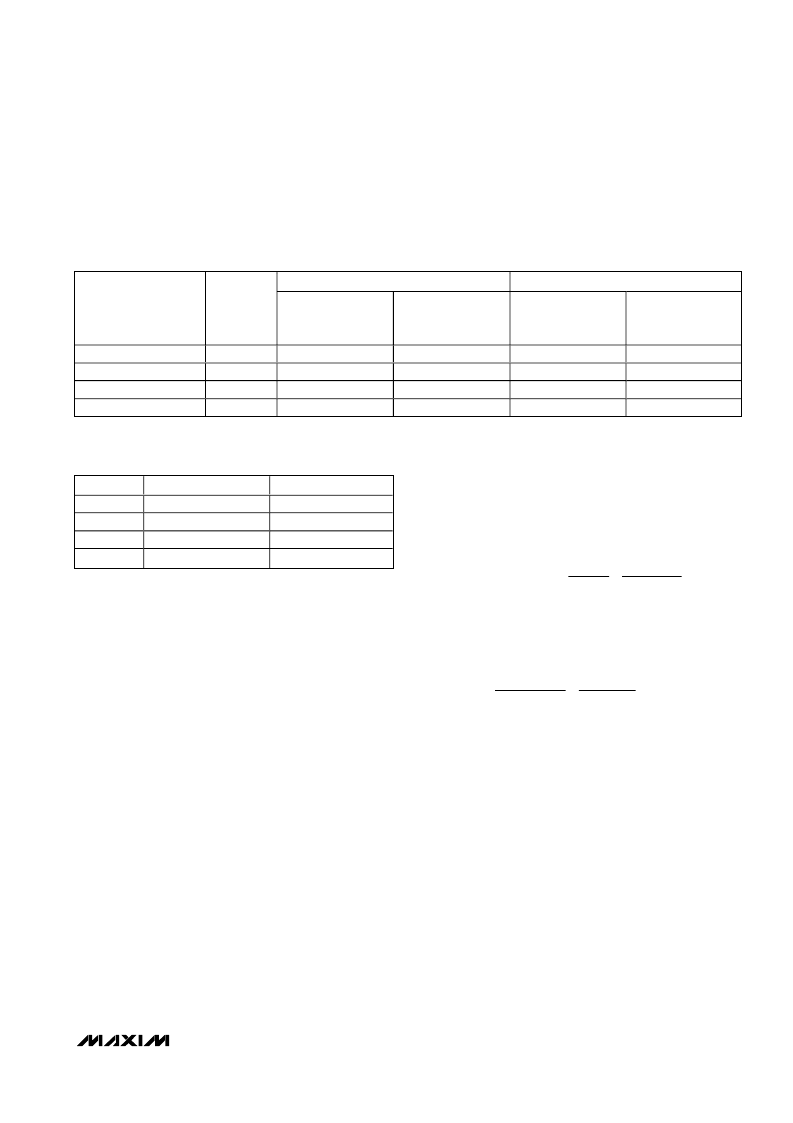- 您現(xiàn)在的位置:買賣IC網(wǎng) > PDF目錄383325 > MAX1540AETJ (MAXIM INTEGRATED PRODUCTS INC) Dual Step-Down Controllers with Saturation Protection, Dynamic Output, and Linear Regulator PDF資料下載
參數(shù)資料
| 型號(hào): | MAX1540AETJ |
| 廠商: | MAXIM INTEGRATED PRODUCTS INC |
| 元件分類: | 穩(wěn)壓器 |
| 英文描述: | Dual Step-Down Controllers with Saturation Protection, Dynamic Output, and Linear Regulator |
| 中文描述: | DUAL SWITCHING CONTROLLER, 620 kHz SWITCHING FREQ-MAX, QCC32 |
| 封裝: | 5 X 5 MM, 0.80 MM HEIGHT, MO-220-WHHD-2, TQFN-32 |
| 文件頁(yè)數(shù): | 25/49頁(yè) |
| 文件大?。?/td> | 794K |
| 代理商: | MAX1540AETJ |
第1頁(yè)第2頁(yè)第3頁(yè)第4頁(yè)第5頁(yè)第6頁(yè)第7頁(yè)第8頁(yè)第9頁(yè)第10頁(yè)第11頁(yè)第12頁(yè)第13頁(yè)第14頁(yè)第15頁(yè)第16頁(yè)第17頁(yè)第18頁(yè)第19頁(yè)第20頁(yè)第21頁(yè)第22頁(yè)第23頁(yè)第24頁(yè)當(dāng)前第25頁(yè)第26頁(yè)第27頁(yè)第28頁(yè)第29頁(yè)第30頁(yè)第31頁(yè)第32頁(yè)第33頁(yè)第34頁(yè)第35頁(yè)第36頁(yè)第37頁(yè)第38頁(yè)第39頁(yè)第40頁(yè)第41頁(yè)第42頁(yè)第43頁(yè)第44頁(yè)第45頁(yè)第46頁(yè)第47頁(yè)第48頁(yè)第49頁(yè)

ing the high-side switch, inductor, and PC board resis-
tances; and t
ON
is the on-time calculated by the
MAX1540A/MAX1541.
Light-Load Operation (
SKIP
)
The four-level
SKIP
input selects light-load, pulse-skip-
ping operation by independently enabling or disabling
the zero-crossing comparator for each controller (Table
4). When the zero-crossing comparator is enabled, the
controller forces DL_ low when the current-sense inputs
detect zero inductor current. This keeps the inductor
from discharging the output capacitors and forces the
controller to skip pulses under light-load conditions to
avoid overcharging the output. When the zero-crossing
comparator is disabled, the controller maintains PWM
operation under light-load conditions (see the
Forced-
PWM Mode
section).
Automatic Pulse-Skipping Mode
In skip mode, an inherent automatic switchover to PFM
takes place at light loads (Figure 3). This switchover is
affected by a comparator that truncates the low-side
switch on-time at the inductor current’s zero crossing.
The zero-crossing comparator differentially senses the
inductor current across the current-sense inputs (CSP_
to CSN_). Once V
CSP_
- V
CSN_
drops below 5% of the
current-limit threshold (2.5mV for the default 50mV cur-
rent-limit threshold), the comparator forces DL_ low
(Figure 3). This mechanism causes the threshold
between pulse-skipping PFM and nonskipping PWM
operation to coincide with the boundary between con-
tinuous and discontinuous inductor-current operation
(also known as the “critical-conduction” point). The
load-current level at which PFM/PWM crossover
occurs, I
LOAD(SKIP)
, is equal to half the peak-to-peak
ripple current, which is a function of the inductor value
(Figure 4). This threshold is relatively constant, with
only a minor dependence on battery voltage:
where K is the on-time scale factor (Table 3). For exam-
ple, in the MAX1541 Standard Application Circuit
(Figure 12) (K = 3.0μs, V
OUT2
= 2.5V, V
IN
= 12V, and L
= 4.3μH), the pulse-skipping switchover occurs at:
The crossover point occurs at an even lower value if a
swinging (soft-saturation) inductor is used. The switch-
ing waveforms may appear noisy and asynchronous
when light loading causes pulse-skipping operation,
but this is a normal operating condition that results in
high light-load efficiency. Trade-offs in PFM noise vs.
light-load efficiency are made by varying the inductor
value. Generally, low inductor values produce a broad-
er efficiency vs. load curve, while higher values result in
higher full-load efficiency (assuming that the coil resis-
tance remains fixed) and less output voltage ripple.
Penalties for using higher inductor values include larger
physical size and degraded load-transient response
(especially at low input-voltage levels).
DC-output accuracy specifications refer to the thresh-
old of the error comparator. When the inductor is in
continuous conduction, the MAX1540A/MAX1541 regu-
late the valley of the output ripple, so the actual DC out-
put voltage is higher than the trip level by 50% of the
output ripple voltage. In discontinuous conduction
.
.
2.5V
2 4.3 H
3
s
12V-2.5V
12V
×
=
0
0 69
μ
A
I
LOAD(SKIP)
OUT
V
2L
IN
OUT
IN
V
K
V
-V
≈
M
Dual Step-Down Controllers with Saturation
Protection, Dynamic Output, and Linear Regulator
______________________________________________________________________________________
25
Table 3. Approximate K-Factor Errors
CONTROLLER 1 (OUT1)
CONTROLLER 2 (OUT2)
NOMINAL TON
SETTING (kHz)
K-FACTOR
ERROR (%)
TYPICAL
K-FACTOR
(μs)
MINIMUM V
IN
AT
V
OUT1
= 1.8V*
(V)
TYPICAL
K-FACTOR
(μs)
MINIMUM V
IN
AT
V
OUT2
= 2.5V*
(V)
200kHz (TON = V
CC
)
300kHz (TON = open)
420kHz (TON = REF)
540kHz (TON = GND)
±10
±10
±12.5
±12.5
4.5 (235kHz)
3.0 (345kHz)
2.2 (485kHz)
1.7 (620kHz)
2.28
2.52
2.91
3.42
6.2 (170kHz)
4.1 (255kHz)
3.0 (355kHz)
2.3 (460kHz)
2.96
3.18
3.48
3.87
*
See the Step-Down Converter Dropout Performance section (h = 1.5 and worst-case K-factor value used).
Table 4.
SKIP
Configuration Table
SKIP
V
CC
Open
REF
GND
OUT1 MODE
Forced PWM
Forced PWM
Pulse skipping
Pulse skipping
OUT2 MODE
Forced PWM
Pulse skipping
Forced PWM
Pulse skipping
相關(guān)PDF資料 |
PDF描述 |
|---|---|
| MAX1543 | TFT LCD DC-to-DC Converter with Operational Amplifiers |
| MAX1542 | TFT LCD DC-to-DC Converter with Operational Amplifiers |
| MAX1542-MAX1543 | TFT LCD DC-to-DC Converter with Operational Amplifiers |
| MAX1543ETP | TFT LCD DC-to-DC Converter with Operational Amplifiers |
| MAX1542ETP | TFT LCD DC-to-DC Converter with Operational Amplifiers |
相關(guān)代理商/技術(shù)參數(shù) |
參數(shù)描述 |
|---|---|
| MAX1540AETJ+ | 功能描述:DC/DC 開關(guān)控制器 Dual Step-Down Ctlr w/Saturation Prot RoHS:否 制造商:Texas Instruments 輸入電壓:6 V to 100 V 開關(guān)頻率: 輸出電壓:1.215 V to 80 V 輸出電流:3.5 A 輸出端數(shù)量:1 最大工作溫度:+ 125 C 安裝風(fēng)格: 封裝 / 箱體:CPAK |
| MAX1540AETJ+T | 功能描述:DC/DC 開關(guān)控制器 Dual Step-Down Ctlr w/Saturation Prot RoHS:否 制造商:Texas Instruments 輸入電壓:6 V to 100 V 開關(guān)頻率: 輸出電壓:1.215 V to 80 V 輸出電流:3.5 A 輸出端數(shù)量:1 最大工作溫度:+ 125 C 安裝風(fēng)格: 封裝 / 箱體:CPAK |
| MAX1540ETJ | 功能描述:DC/DC 開關(guān)控制器 RoHS:否 制造商:Texas Instruments 輸入電壓:6 V to 100 V 開關(guān)頻率: 輸出電壓:1.215 V to 80 V 輸出電流:3.5 A 輸出端數(shù)量:1 最大工作溫度:+ 125 C 安裝風(fēng)格: 封裝 / 箱體:CPAK |
| MAX1540ETJ+ | 功能描述:DC/DC 開關(guān)控制器 Dual Step-Down Ctlr RoHS:否 制造商:Texas Instruments 輸入電壓:6 V to 100 V 開關(guān)頻率: 輸出電壓:1.215 V to 80 V 輸出電流:3.5 A 輸出端數(shù)量:1 最大工作溫度:+ 125 C 安裝風(fēng)格: 封裝 / 箱體:CPAK |
| MAX1540ETJ+T | 功能描述:DC/DC 開關(guān)控制器 Dual Step-Down Ctlr RoHS:否 制造商:Texas Instruments 輸入電壓:6 V to 100 V 開關(guān)頻率: 輸出電壓:1.215 V to 80 V 輸出電流:3.5 A 輸出端數(shù)量:1 最大工作溫度:+ 125 C 安裝風(fēng)格: 封裝 / 箱體:CPAK |
發(fā)布緊急采購(gòu),3分鐘左右您將得到回復(fù)。